
BAN PHU CITADEL
I. LOCATION, GEOGRAPHY
The relic of Ban Phu Citadel (commonly known by local people as Hoang Cong Chat Temple) is located in Groups 14, 15, 16, 22, 23 (after the merger now belongs to Ban Phu Village, Tan Lap Village, and Tran Phu Village), Noong Het Commune, Dien Bien District, Dien Bien Province. It is 8 km south of Dien Bien Phu city center.

(Ban Phu Citadel from above)
II. OVERVIEW OF THE SITE
Ban Phu Citadel was built by General Hoang Cong Chat and the people of various ethnic groups for over 4 years from 1758 to 1762. The relic was built by General Hoang Cong Chat and the people of various ethnic groups in 4 years from 1758 to 1762. The citadel is located in the rich Muong Thanh field, a large granary of the whole Northwest region. According to folklore, the citadel covered an area of 80 acres wide, built in a very flexible shape based on nature, looking overall like a pentagon with five uneven sides. The two western edges are based on The Nam Rom River, the southern edge is based on Huoi Le stream, the eastern edge runs parallel to the national highway, and the northern edge overlooks along Muong Thanh field. The citadel’s wall is made of soil, 5m high, with a width ranging from 4 to 5 meters, and a base width of 10 meters. The Citadel is divided into two separate areas: the inner area and the outer area.
The Citadel has 4 gates: The front gate faces Nam Rom River, towards the West; the rear gate faces the national highway, towards the East; the right gate faces the North and the left gate faces the South. At each gate and corner of the Citadel, there is a high earth platform for guard tower (Some traces of these guard tower foundations still exist today, standing outside looking in, these guard towers are built high like hills).
In 1981, Ban Phu Citadel was classified as a national-level historical and cultural relic according to Decision No. 10/QD-VHTT, dated February 9, 1981, issued by the Ministry of Culture and Information (now the Ministry of Culture, Sports and Tourism).
III. EVENTS, HISTORICAL FIGURES, CHARACTERISTICS OF THE RELIC
In the 18th century, the feudal central royal court was weak and chaotic, exacerbated by frequent droughts and floods, causing widespread hunger and hardship among the people. Due to extreme poverty and loss of trust in the ruling dynasty, the people revolted against the royal court in many places, making the 18th century known for numerous peasant uprisings.
One of the notable struggles of the peasants was led by General Hoang Cong Chat (also known as Hoang Cong Thu - Leader of the peasant uprising in Son Nam Ha region (1739 - 1769 during the reign of Le Trung Hung). He was born in 1706 and passed away in 1767, hailing from Hoang Xa village, Thu Tri district, Son Nam Ha prefecture, now part of Nguyen Xa commune, Vu Thu district, Thai Binh province.
Coming from a patriotic family lineage that served the king in fighting foreign invaders (during the reign of Le Trung Hung, ancestors of the Hoang family lineage were honored by King Canh Hung), he led a peasant uprising movement that lasted for 30 years from 1739 to 1769. The uprising erupted in Son - Nam region (Thai Binh, Nam Dinh, and part of present-day Ninh Binh province), during his activities here, Hoang Cong Chat collaborated with many peasant leaders such as Nguyen Tuyen, Nguyen Cu, Nguyen Huu Cau... to resist the feudal government of Le Trinh. By 1748, Trinh's forces had concentrated on suppressing the uprisings, facing difficulties in the delta region, the rebel forces advanced their operations to the upper areas of Thanh Hoa province.
In 1751, the rebel army led by General Hoang Cong Chat from Son Nam (Thai Binh) gradually advanced to Hung Hoa (in the present-day Northwest region), where Hoang Cong Chat received wholehearted support from the minority ethnic groups of the Northwest. During this period, the Northwest region was constantly invaded by foreign aggressors who caused much destruction and atrocities. The Phe invaders came from Yunnan, China to plunder the Muong regions of the Northwest of our country, they were very strong and extremely brutal, looting, killing innocent people, and posing a great threat to the entire population of the Northwest.
During that period, in Muong Thanh Pha, Chau Tin Tong led the Phe invaders from the upper regions of Laos and Yunnan (China) to raid and commit atrocities, their crimes were countless. In present-day Dien Bien, there are still some remnants left by the Phe invaders, such as the Tông Khao field in Doc Lap. In the past, the invaders captured all the children in the surrounding area and herded them into a low-lying area before releasing a flood to drown them. After the water receded, the bodies of the drowned children were left stark white, hence the locals called this field Tông Khao (White Field).
Faced with the atrocities of the Phe invaders, the people of various ethnic groups in Muong Thanh were extremely resentful. At that time, two Thai leaders, General Ngai and General Khanh, who came from poor peasant families in Muong Sai (Son La), rose up to gather and lead the people of Muong Thanh to resist the Phe invaders. However, due to their limited strength, the rebel army led by these two leaders suffered heavy losses and had to retreat to high mountain areas to preserve their forces.
At this time, upon hearing that the rebel army led by Hoang Cong Chat was operating in the upper regions of Laos, Generals Ngai and Khanh sought out Hoang Cong Chat. With their support, Hoang Cong Chat joined forces with Generals Ngai and Khanh to lead the rebel army and the people through the forested mountain route of Song Ma towards liberating Muong Thanh.
The first base of the rebel army was established in Song Ma district (Son La), and the army's strength was supplemented daily with diverse ethnic groups: Kinh people, Thai people, Xa people, Lu people... The rebel army besieged Tam Van Citadel (Sam Mun Citadel) and launched a strong attack around the end of 1753 and the beginning of 1754.
The battle was fierce, and the rebel army managed to corner the Phe invaders in an area in the Muong Thanh field called Pu Vang. However, here the Phe used large guns loaded with lead bullets to halt the advance of the rebel army. Subsequently, Generals Ngai and Khanh devised a plan to disguise Lự and Lao people as soldiers of Pha Chau Tin Tong, allowing them to infiltrate the Citadel and attack from within. Meanwhile, Hoang Cong Chat's rebel army attacked from outside. Faced with a powerful and unexpected assault from the rebel army, the Phe invaders were caught off guard and managed to kill Pha Chau Tin Tong. The remaining Phe soldiers fled to Laos. After this battle where blood flowed like a stream, the fighting area was named Pu Vang (now at the foot of Doc Lap hill; Pu means mountain, Vang means area). From then on, Muong Thanh was liberated, and the people of various ethnic groups were freed from the hardships caused by the Phe invaders.
After the victory in 1754, when defeating the Phe invaders, Hoang Cong Chat temporarily stationed in Tam Van citadel to consolidate his forces, build Muong Thanh into a long-term stronghold to resist foreign invaders, and at the same time establish Muong Thanh as a large center, a Citadel in the Northwest region. During the period stationed in Tam Van Citadel, he realized that although the Citadel was vast, there were many vulnerabilities, the defense arrangements were inadequate, and it was not suitable for long-term operations. In 1758, Hoang Cong Chat decided to build another citadel called Chieng Le (now known as Ban Phu Citadel).
In 1767, as the strength of the rebel army was growing rapidly, Hoang Cong Chat fell ill and passed away. After his death, his son Hoang Cong Toan took over. Around this time, peasant uprisings in the delta region were being suppressed, and the Trinh lords had the opportunity to gather forces to counter the uprisings of Hoang Cong Chat's rebel army. In this situation, in February 1768, Trinh Sam sent Nguyen Dinh Huan as the commander to lead troops to Muong Thanh to suppress the uprising led by Hoang Cong Chat. Initially, when the Trinh troops advanced, the people of ethnic groups in the Northwest implemented a policy of non-cooperation, such as abandoning their homes to go into the forests. This made Nguyen Dinh Huan fearful, thinking he would be ambushed and forced to retreat. Among the generals was Doan Nguyen Thuc who reported to Trinh Sam about Dinh Huan's actions. Therefore, Trinh Sam called Dinh Huan back and appointed Doan Nguyen Thuc to continue leading the oppression. The Trinh troops advanced along the Song Ma River to attack Muong Thanh. Within just over a month, their forces gathered in the Tuần Giáo region, including Muong E, Muong Quai, and Muong Ang.
After several attacks, the Trinh troops advanced into Muong Thanh. Hoang Cong Toan and his generals were caught off guard and, internal conflicts within the rebel army led to its quick disintegration.
Although the uprising failed, it can be said that Hoang Cong Chat fought and sacrificed for freedom. He was trusted and beloved by the people of various ethnic groups in the Northwest and revered as a hero. The uprising he led received unanimous support from the people of the Northwest and achieved certain successes. For nearly 20 years, the lives of the people in the Northwest, especially the Muong Thanh - Dien Bien ethnic groups, were prosperous and happy.
IV. RELIGIOUS AND CULTURAL ACTIVITIES RELATED TO RELICS
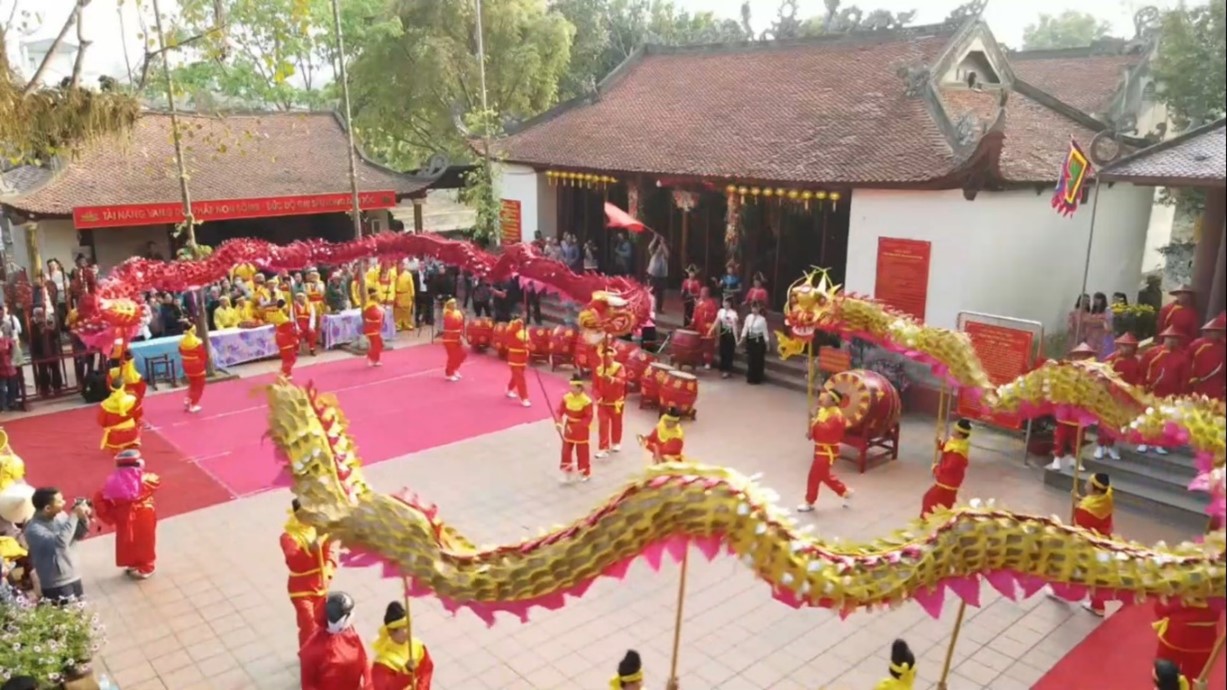
The Ban Phu Citadel festival used to take place in the summer (specifically on the 5th day of the 5th lunar month each year). It is believed to be the day when the rebel army achieved victory over the Phe invaders and a day of great triumph for the area. On this occasion, the Thai people offer "Then Chat" rituals to wish for everyone's health, and pray for favorable rain and wind for a bountiful harvest. People of various ethnic groups enthusiastically gather to attend the festival and watch performances depicting the heroic battles of the rebel army against the invaders, preserving the peace in the Muong region.
Several years later, to align with the local customs and traditions, the Ban Phu Citadel festival was rescheduled to coincide with other festivals in the region held by the Thai people in the second lunar month of each year. The festival lasts for five days known as "Cắm mướng, ỉn phủ" (Kiêng mường, chơi phủ). It starts from the night of the 24th to the 28th of the 2nd lunar month, with the main day being the anniversary of Hoang Cong Chat's death (25th day).
From 1990 to the present, the Department of Culture, Information, Sports (now the Department of Culture, Sports, and Tourism) has collaborated with the provincial People's Committee to coordinate with the district People's Committee of Dien Bien to restore and organize the festival with a wide range of diverse activities. The festival is held over two days (24th - 25th day of the 2nd lunar month each year) to commemorate the hero Hoang Cong Chat, a prominent peasant leader in the 18th century, and Generals Ngai and Khanh who bravely fought alongside the Muong Thanh people to defeat the Phe invaders, safeguarding the Muong region and the Northwestern mountains and forests.
The festival contributes to fostering patriotism, national pride, deep gratitude towards national heroes, and promoting the tradition of "When drinking water, think of its source”. It enhances self-reliance, and creativity in production and labor, in combat, while also raising awareness for preserving and promoting the cultural values of heroic Dien Bien Phu.
The Ban Phu Citadel festival has been recognized as a national intangible cultural heritage in Decision No. 1877/QD-BVHTTDL dated June 8, 2025, by the Ministry of Culture, Sports, and Tourism regarding the announcement of the list of national intangible cultural heritage.
1. Ceremony Section:
At the festival, the ceremony section is conducted with solemnity and reverence, following sacred rituals that have been preserved and passed down through generations.
The ceremony begins with the resounding sound of majestic drums, creating a solemn and festive atmosphere at the event.
After the flag-raising ceremony comes a minute of silence to commemorate and honor the heroic martyrs who sacrificed their lives to defend the nation.
The memorial ceremony for the generals consists of three parts: Majestic background music; next is the ritual procession, offering sacrifices, and a stage reenactment of historical events.
The procession of gifts: The commander of the procession was an elderly man, dressed formally, walking majestically, showing the deep gratitude of the people of all ethnic groups to the hero of Hoang Cong Chat and the two generals Ngai and Khanh who contributed to driving out foreign invaders. The procession includes lion and dragon dance teams, and a procession team wearing festival costumes. The soldiers of the rebel army wear military uniforms, holding spears pointed towards the sky. Participants holding flags and civilians are dressed in solemn attire.
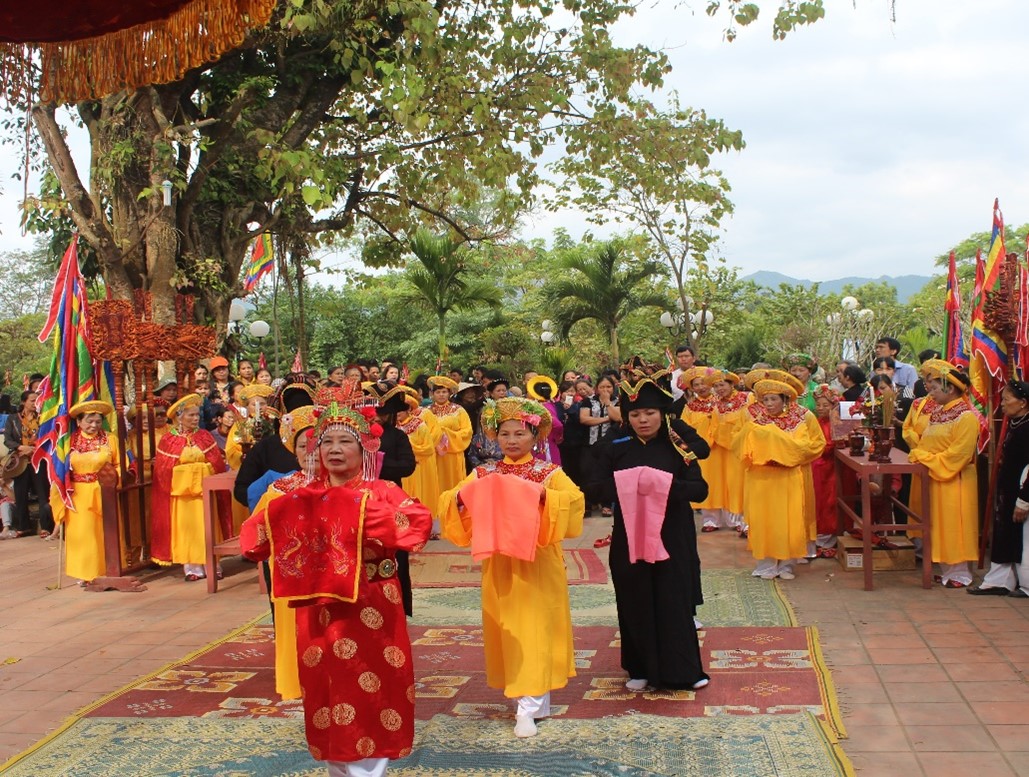
The historical reenactment on stage consists of three parts: Historical background setting, the generals leading the people in fighting against the invaders, the liberation of Muong Thanh, highlighting the role and honoring the leaders who saved the people, showcasing the unity spirit of the Northwestern people, depicting the enthusiastic support of the people in fighting against the invaders. The ensemble of drums, gongs, traditional musical instruments, resonant, majestic, and solemn sounds; praying for national peace and prosperity.
2. Festival Section:
In addition to traditional cultural and religious practices, the festival section provides a wholesome playground, enhancing the cultural and spiritual life of the local community with a variety of cultural and artistic activities. These include art exhibitions showcasing paintings and photos related to the heroic deeds of Hoang Cong Chat's rebel army, traditional folk games such as Tug of war, archery, pole pushing, walking on stilts, spinning tops, traditional cuisine of ethnic cultures, cultural art performances, and traditional Thai ethnic group dances symbolizing unity and solidarity during the festival.
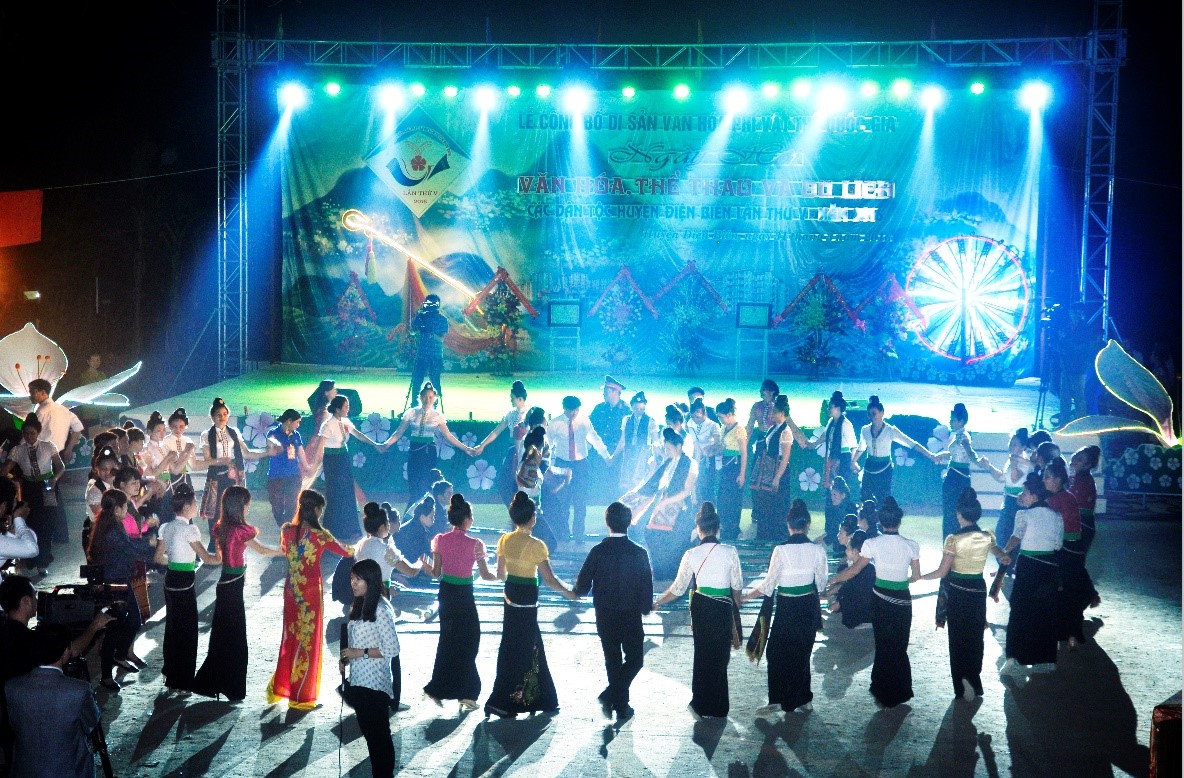
The Ban Phu Citadel Festival is organized annually not only as a religious activity but also as a cultural event, enriching the cultural and spiritual life of the people of various ethnic groups in the area. Organizing the festival, is also an opportunity to promote and educate the national traditions, the pride of the nation in each individual. At the same time, it sparks the spirit of solidarity among ethnic groups, between regions, working together to build and protect the Fatherland.
V. SITE COMPLEX
The Ban Phu Citadel site is divided into two distinct areas: the Inner Citadel and the Outer Citadel.
1. Inner citadel:
The Inner Citadel is the central area of the Ban Phu Citadel site, where the leader Hoang Cong Chat and the generals resided. The citadel has a rectangular structure, covering an area of 27,000m2, constructed with earth, measuring 180m in length and 150m in width. Surrounding the outer part of the citadel is a moat with a depth ranging from 3m to 5m, and outside the base of the citadel, dense bamboo is planted to create a barrier against external attacks. This area is considered the brain and stronghold of the rebel army to protect and develop their prestige. (Today, it is the location of the Hoang Cong Chat Temple and statues of his six famous generals).
2. Outer Citadel:
The Outer Citadel is also constructed with earth, shaped like a pentagon, with a perimeter of 3,300m; width of 80m, wall width of 5m, and base width of 10m, standing at a height of 5m. This area served as the barracks for soldiers, military storage area, armory, stables for horses, elephant pens, etc. The Outer Citadel features 130 ponds of various shapes: square, round, triangle, hexagon, and octagon for water supply and aquatic training. There are four gates - front, rear, left, right - each with guard towers and watchtowers for sentries(Today, only one main gate leading into the Citadel remains, built in a grand vaulted style, sturdy and imposing). Surrounding the base of the Citadel on the outside is a deep moat, lined with dense bamboo to fortify and defend the entire Citadel and impede enemy advances. With rudimentary tools and equipment, the Ban Phu Citadel is considered a solid defensive structure, showcasing sophisticated techniques and creativity during that historical period.
VI. STRUCTURES WITHIN THE HISTORICAL SITE
1. Hoang Cong Chat Temple

After the passing of General Hoang Cong Chat and the generals Ngai and Khanh, the people of Dien Bien province erected the Hoang Cong Chat Temple. Initially, in the years before 1980, the temple was constructed with bamboo, consisting of two sections with a thatched grass roof. In 1994 - 1995, the temple was renovated and rebuilt using bricks, and wood, with a tiled roof. From 2000 to 2003, on the original state-owned land, the government invested in embellishing and rebuilding the Temple with an area of 116m2 (5 sections). The temple was built in the Nguyen dynasty style, structured in the "Trồng rường giá chiêng" architectural style, with columns and rafters layered on top of each other, featuring various carved motifs such as dragons and phoenixes, moons, plants, and flowers. The main facade of the temple was made of ironwood, with carved decorations including horizontal lacquered boards, couplets, inscriptions, and altar statues all crafted from precious wood. Inside the temple, there are three large horizontal lacquered boards: "Hoang Cong Divine Lord", "National Guardian Spirit", "Eternal Anniversary Shrine", and six Han-Nom couplets placed in solemn positions within the temple.
In front of the temple is a brick courtyard surrounded by a fence and ornamental trees. Particularly, in front of the temple stands an ancient Banyan tree over 200 years old, with three trunks of Banyan, Bodhi, and Malayan Banyan tree growing from the same root, providing shade and symbolizing the unity of different ethnic groups. The lush foliage creates a serene and sacred atmosphere for the temple.
2. Commemorative House
Located next to the temple, the Commemorative House stands at a height of 1.2 meters and a width of 0.8 meters. The lower part is constructed with concrete, while the roof is tiled, and the floor is paved with dark-colored interlocking tiles. This is where a summary of the achievements and activities of General Hoang Cong Chat in the 18th century is presented.
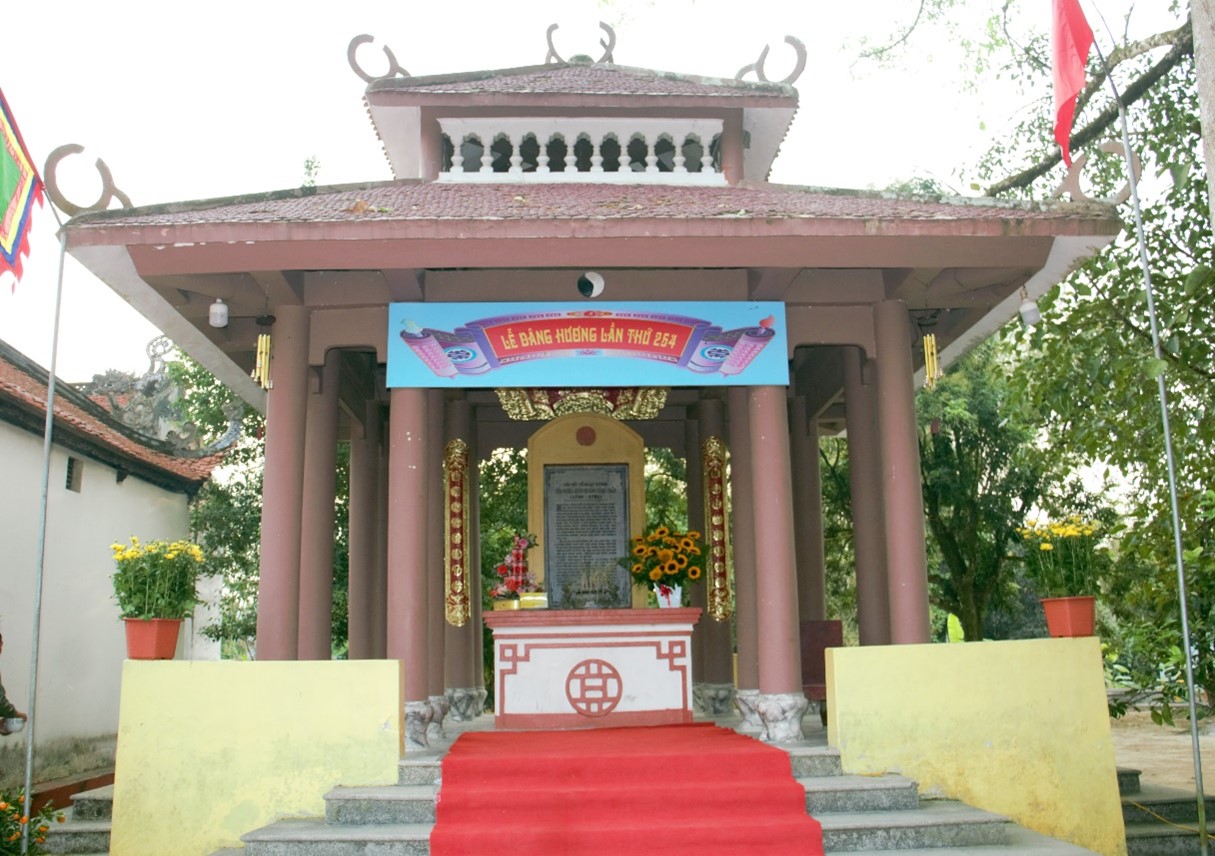
3. House of Rituals and Guard House
The construction area is 65m2 (3 sections), a type of 4-level house with a reinforced concrete frame, covered walls, steel-reinforced concrete ceiling, tiled roof, and a dark-colored interlocking tile floor.
4. Thai Cultural Stilt House
The stilt house is built to serve as a communal cultural activity space and to display artifacts. The construction area is 263.3m2, a type of 3-level stilt house with a load-bearing reinforced concrete frame, steel-reinforced concrete rafters, a 70% sloping concrete roof with tiled roofing, a Taiwanese plastic ceiling, a 1.2m-wide surrounding corridor, and an N3 wood floor.
5. Gate and Citadel Wall:
The gate of the citadel is grand and majestic, featuring ancient architectural designs, that blend well with the landscape. Above the gate, there are watchtowers and lookout towers for ventilation and scenic views. The Citadel wall is artificially constructed from soil, each side extending 50m, with stone blocks on both sides forming the wall, and the middle part of the wall compacted with soil, with a 10m-wide base, a 5m-wide wall face, and a height of 5m.
In addition to the mentioned structures, within the citadel are lotus ponds with stone embankments, a system of brick pathways, and spacious grounds serving cultural activities, festivals, recreational activities, and sports competitions.
VII. VALUES OF THE BAN PHU CITADEL HISTORICAL SITE
1. Historical and Cultural Values:
The Ban Phu Citadel site is a significant historical landmark that marks an important chapter in the history of Vietnam's resistance against foreign invaders and the solid defense of the nation's border by General Hoang Cong Chat and the people of Northwestern Vietnam in the 18th century.
The site symbolizes the deep unity among different ethnic groups from the upstream and downstream regions in the fight against foreign invaders to protect their homeland.
Moreover, the relic site serves as a profound revolutionary school, propagating education for generations of Vietnamese about the heroic traditions and sacrifices of the local ethnic groups in defending sovereignty and territorial integrity. It helps the current and future generations to appreciate and cherish the values of the past left by their ancestors.
2. Scientific Value:
The Ban Phu Citadel is a unique military architectural structure built with earth using rudimentary tools without the influence of chemicals or modern equipment. Through creative thinking and unified efforts, General Hoang Cong Chat led the people to construct a solid and resilient Citadel spanning 80 acres for defense and protection.
3. Tourism Value:
In addition to its historical and cultural significance, the Ban Phu Citadel site is a national cultural asset. It has become a vital cultural and spiritual hub for the people of Dien Bien, presenting tourism potential for sustainable economic development.
Over the years, the site has welcomed millions of visitors for exploration, research, tribute-paying, and remembrance of General Hoang Cong Chat and other national heroes. It has emerged as an attractive tourist destination for both domestic and international visitors when visiting Dien Bien.
 Tết té nước (Bu Huột Nặm) – Nét văn hóa độc đáo của đồng bào dân tộc Lào, huyện Điện Biên
Tết té nước (Bu Huột Nặm) – Nét văn hóa độc đáo của đồng bào dân tộc Lào, huyện Điện Biên
 SHOW THỰC CẢNH VÀ GIỚI THIỆU HUYỀN TÍCH, LỊCH SỬ VÀ CÁC VŨ ĐIỆU DÂN GIAN ĐẶC SẮC, VĂN HÓA DÂN TỘC THÁI “HUYỀN TÍCH U VA”
SHOW THỰC CẢNH VÀ GIỚI THIỆU HUYỀN TÍCH, LỊCH SỬ VÀ CÁC VŨ ĐIỆU DÂN GIAN ĐẶC SẮC, VĂN HÓA DÂN TỘC THÁI “HUYỀN TÍCH U VA”
 Show thực cảnh và giới thiệu huyền tích, lịch sử và các vũ điệu dân gian đặc sắc, văn hóa dân tộc Thái “Huyền tích U Va”
Show thực cảnh và giới thiệu huyền tích, lịch sử và các vũ điệu dân gian đặc sắc, văn hóa dân tộc Thái “Huyền tích U Va”
 Sôi nổi Ngày hội Giao lưu văn hóa dân tộc Mông tại Na Ư
Sôi nổi Ngày hội Giao lưu văn hóa dân tộc Mông tại Na Ư
 Lễ hội mừng cơm mới dân tộc Thái huyện Điện Biên
Lễ hội mừng cơm mới dân tộc Thái huyện Điện Biên
 Lễ hội cầu mưa dân tộc Thái tại bản Liếng, xã Noong Luống
Lễ hội cầu mưa dân tộc Thái tại bản Liếng, xã Noong Luống
 Độc đáo, tưng bừng Tết Té Nước (Bun Huột Nặm) của dân tộc Lào huyện Điện Biên năm 2024
Độc đáo, tưng bừng Tết Té Nước (Bun Huột Nặm) của dân tộc Lào huyện Điện Biên năm 2024
 TẾT TÉ NƯỚC DÂN TỘC LÀO XÃ NÚA NGAM, HUYỆN ĐIỆN BIÊN NĂM 2024
TẾT TÉ NƯỚC DÂN TỘC LÀO XÃ NÚA NGAM, HUYỆN ĐIỆN BIÊN NĂM 2024
 Khai mạc Lễ hội Thành Bản Phủ, năm 2024
Khai mạc Lễ hội Thành Bản Phủ, năm 2024
 Khai mạc Ngày hội Văn hóa, Thể thao và Du lịch các dân tộc huyện Điện Biên lần thứ X, năm 2024
Khai mạc Ngày hội Văn hóa, Thể thao và Du lịch các dân tộc huyện Điện Biên lần thứ X, năm 2024
 Trang chủ
Trang chủ














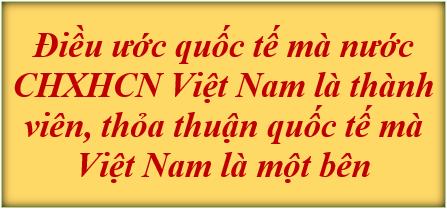

























 - Trung tâm Công nghệ thông tin và Truyền thông tỉnh Điện Biên
- Trung tâm Công nghệ thông tin và Truyền thông tỉnh Điện Biên